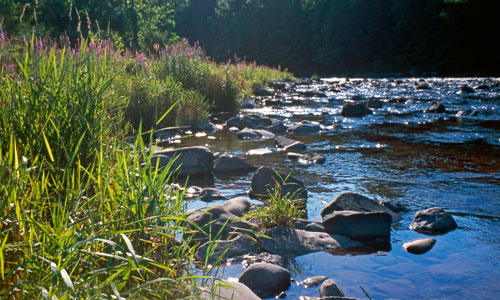
Aquatic habitat refers to areas of the stream corridor regularly covered by flowing water. Aquatic habitats are where plants and animals adapted to living in wet environments are commonly found. Riparian habitat is the transitional zone between the aquatic environment and upland areas only periodically covered by water or adjacent to wetted areas. The Ashokan Watershed Stream Management Program (AWSMP) seeks to enhance aquatic and riparian habitat by encouraging stewardship and protection of existing natural areas and the restoration of degraded habitat.
The AWSMP is funding on-going study of the effects of flooding on trout populations in the Esopus Creek. Some fish sampling indicates a reduction in year classes for trout species due to flooding. Other studies have focused on the spread of Didymo and effects on aquatic habitat in the Esopus Creek.
Stream restoration and stabilization projects undertaken by AWSMP are evaluated for their impact on habitat before they begin. Overall, stream projects are designed to mitigate impacts and create improvements in habitat condition. This is typically achieved by restoring the stream’s ability to clear channel bottoms of fine sediments, recreating channel features like pools and riffles, reconnecting floodplains, removing invasive species, and reestablishing native riparian and floodplain vegetation.
AWSMP participates in the Catskill Regional Invasive Species Partnership (CRISP) and neighboring watershed programs to offer public programs on existing and emerging invasive species threats. We distribute several publications on Japanese Knotweed, an invasive riparian plant that can limit the growth of native vegetation necessary for optimal streambank stability. Other invasives of concern in the watershed include Hemlock Woolly Adelgid, Emerald Ash Borer, and Didymo. Check the News & Events page for volunteer opportunities to restore native riparian habitats or remove invasive plants from streambanks.
